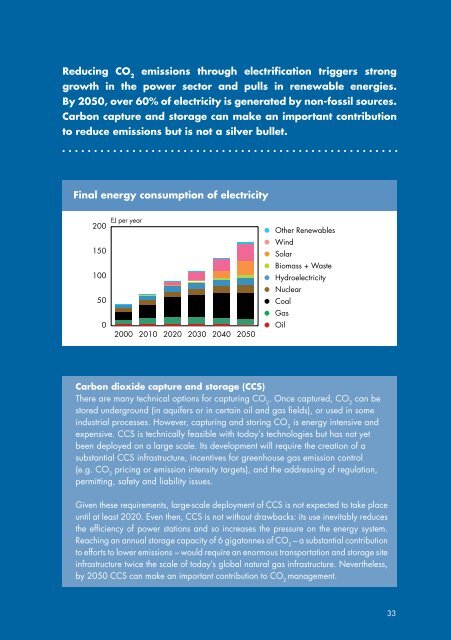Shell energy scenarios to 2050 - Manicore
Shell energy scenarios to 2050 - Manicore
Shell energy scenarios to 2050 - Manicore
You also want an ePaper? Increase the reach of your titles
YUMPU automatically turns print PDFs into web optimized ePapers that Google loves.
Reducing CO 2emissions through electrification triggers stronggrowth in the power sec<strong>to</strong>r and pulls in renewable energies.By <strong>2050</strong>, over 60% of electricity is generated by non-fossil sources.Carbon capture and s<strong>to</strong>rage can make an important contribution<strong>to</strong> reduce emissions but is not a silver bullet.P31New chart <strong>to</strong> comeFinal <strong>energy</strong> consumption of electricityP33EJ per year r2001501005002000 2010 2020 2030 2040 <strong>2050</strong>Other RenewablesOtherWindRenewablesWindSolarSolarBiomass + WasteBiomass + + WWasteHydroelectricityHydroelectricityNuclearNuclearCoalCoalGasGasOil OilOilCarbon dioxide capture and s<strong>to</strong>rage (CCS)There are many technical options for capturing CO 2. Once captured, CO 2can bes<strong>to</strong>red underground (in aquifers or in certain oil and gas fields), or used in someindustrial processes. However, capturing and s<strong>to</strong>ring CO 2is <strong>energy</strong> intensive andexpensive. CCS is technically feasible with <strong>to</strong>day’s technologies but has not yetbeen deployed on a large scale. Its development will require the creation of asubstantial CCS infrastructure, incentives for greenhouse gas emission control(e.g. CO 2pricing or emission intensity targets), and the addressing of regulation,permitting, safety and liability issues.Given these requirements, large-scale deployment of CCS is not expected <strong>to</strong> take placeuntil at least 2020. Even then, CCS is not without drawbacks: its use inevitably reducesthe efficiency of power stations and so increases the pressure on the <strong>energy</strong> system.Reaching an annual s<strong>to</strong>rage capacity of 6 giga<strong>to</strong>nnes of CO 2– a substantial contribution<strong>to</strong> efforts <strong>to</strong> lower emissions – would require an enormous transportation and s<strong>to</strong>rage siteinfrastructure twice the scale of <strong>to</strong>day’s global natural gas infrastructure. Nevertheless,by <strong>2050</strong> CCS can make an important contribution <strong>to</strong> CO 2management.33



